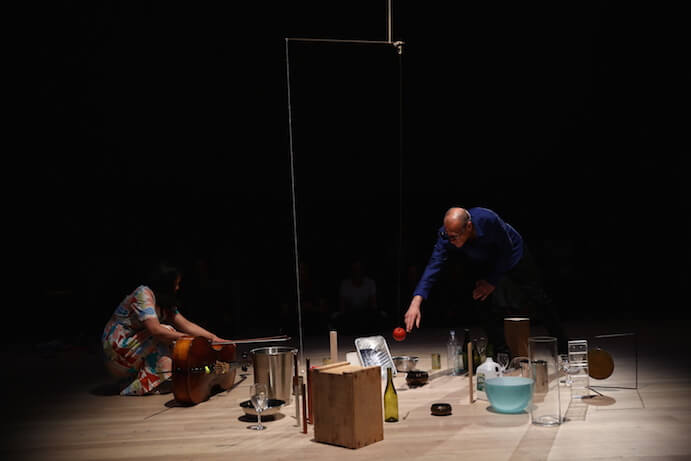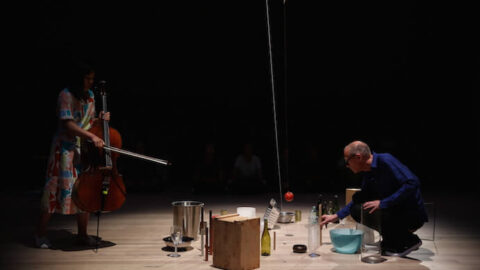Alexander Calder’s first use of sound in sculpture was accidental. “You have weight, form, size, colour, motion and then you have noise,” he said. The Whitney Museum’s Small Sphere and Heavy Sphere 1932/1933 performance on July 19, 2017–part of its Calder: Hypermobility exhibition programming–evolved these last two variables into a chance concert installation. Surrounding the sculpture, Calder’s first hanging mobile, was a light-hearted audience including museum director Adam D. Weinberg and Calder’s grandson Alexander S. C. Rower. A red iron sphere hung from one end of a thin horizontal rod, and a small wooden one dangled off the other. To begin the performance, Christian Marclay would walk with tightrope intention to the sculpture and activate the red iron sphere. The other would immediately curl around the iron sphere’s string and refuse to play. The audience would burst out laughing. But before this, the mobile was tantalizingly still over a gong, glass bottles, and wooden box.
Once set in motion, the spheres created a unique soundscape through unpredictable “impedimenta” collisions. Calder’s sound and chance experiments paved the way for many fabled avant-gardes, famously influencing John Cage. Choreographers Martha Graham and Ruth Page became friends, too, as he bonded genres and revolutionized sculpture with aerial grace. The original work allowed viewers to intervene and rearrange the objects, inviting interaction and releasing control; this performance took that freedom a step further. It substituted random viewers for designated artists and reorganized both the sculpture’s urns and elements. Marclay moved beyond intervention to intensifying the sonic variables. He made several trips in and out of the room to add original or brand-new objects, and organized potential collisions with a plastic tape deck tower and small garden of copper rods. The mobile avoided these; so in return Marclay played the floor, using it as light percussion and to resound a metal bowl.

Unlike static sculpture, a mobile moves into the space around it. It responds to and alters its surroundings. It transforms a static gaze through unique systems of movement. So exactly did Okkyung Lee and her cello become a flesh-and-wood mobile. She walked a slow, crooked square through the room, pausing to jab her cello near an audience nose; twirling it randomly on its peg; holding it near the ground, off the ground, by the neck like a cordless phone. She took up her bow three, four times in the air before playing, admiring the lines it drew from her flexible wrist. She scraped and dragged her cello on the floor in a sure test of The Whitney’s insurance policy. By the end of the performance, she would be both the living Calder extension and its final interaction: she left her cello in the impedimenta collection and walked off drily bowing a cardboard box. In the meantime, she revved engines, creaked doors open, and growled small wolves on her instrument. She masked hyper-alert choices with an aimless, petulant character and made languid jumps from nature sounds to cartoon twangs. She broke silence with flecks of onomatopoeia or bowing the cello side curve. Eventually she entered the mobile’s spotlight, set the cello down, and bowed the lip of a metal trash bin to rich, eternal resonance.
Sphere started out teasing and finished tense. “It misses more than it hits,” said one audience member. “The feeling it’s gonna…” With fewer impediments in the beginning, the mobile swings broadly. Anticipation is almost as much fun as a hit. By the end of the hour, however, the floor was dense with objects and potentiality. Marclay and Lee were suspended between insecure cause and effect, at once in and out of control of their concertized environment. Marclay sifted the sounds he preferred, and inserted intentional timbres; Lee watched the spectacle and deployed every unknown cello technique to participate. But still, the mobile knocked the cookie tin free without permission. It rolled steadily toward the audience, tipping onto the floor just before striking feet.
























